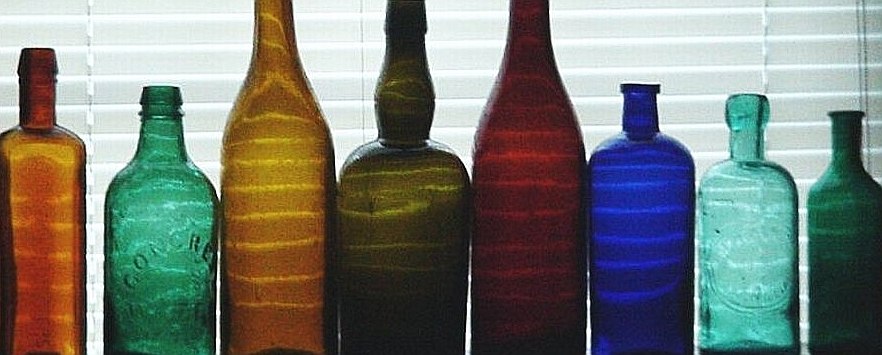Glass Insulator Manufacturers
On this webpage I’ve compiled a list of glass insulator manufacturers — factories that made (or are believed to have produced) glass electrical insulators. Although primarily listing factories that were located here in the United States of America, I’ve also included a few Canadian firms.
(For a general overview / summary /history about antique and vintage glass electrical insulators, please check out my webpage here.)
If you have additional information, corrections, or clarifications, please contact me (at the email address listed under CONTACT INFO /NOTES or CONTACT INFORMATION ) as I am continually looking for the most accurate data available on these companies. Sources of some of the information is included after each entry if I have it available.
Some of the information on this page is from research originally compiled by “Woody” (N. R. Woodward ~ 1927-2019), creator of the “CD” (Consolidated Design) numbering system used by collectors for identifying and cataloging insulators. Also, a portion of the info is found in various articles in the two-volume reference book “INSULATORS: A HISTORY AND GUIDE TO NORTH AMERICAN GLASS PINTYPE INSULATORS ” by John & Carol McDougald (1990). Those books are no longer in print, but I would heartily recommend them as an important part of any serious insulator collector’s library.
NOTE: The year dates given are the best information I have currently. Some information is questionable or incomplete, and I plan to update this webpage as I learn more. This list does not include “end user” companies (telephone/telegraph companies, railroads, electric power utilities, etc) that had insulators made for them with embossing such as “A.T.& T.”, “C.P.R.”, “G.E.”, etc, but only lists the actual manufacturers of these insulators.
For a listing of some primary embossings (markings) found on glass insulators, and the glass factories that may have produced them: Glass Insulator Embossings.
American Insulator Company
Boston area, MA (c.1883-1886?)
Although insulators made by (or for) this company are marked “AM.INSULATOR CO. N.Y.” (on the base), business offices were located in both New York and Boston according to directory listings. Possibly the actual manufacturing facility was located in the Boston area, and may have been the American Iron Glass Pipe & Plate Company (Iron Glass Works) factory at Haverhill, Massachusetts. In addition, recent evidence has surfaced which proves that the Lyndeborough Glass Company, South Lyndeborough, New Hampshire (1866-1888), produced many of the American Insulator Company-embossed insulators.
[McDougald-1990: Joe Maurath, Jr., Bob Fuqua; Mark Newton]
American Iron Glass Pipe & Plate Company (aka Iron Glass Works)
Haverhill, MA (1884-1885?)
There is a possibility this was one of the factory locations where some of the American Insulator Company insulators were produced (besides the Lyndeboro Glass Company, see that entry). At least some of the “National Insulator Co” embossed insulators were almost certainly made here.
[McDougald-1990: Joe Maurath, Jr., Bob Fuqua]
Armstrong Cork Corporation
(See Whitall Tatum Company page for more information.)
Baltimore Glass Manufacturing Company
Baltimore, MD (1895-1897)
Insulators embossed “B.G.M.CO.” were produced by this company.
Bay State Glass Works
East Cambridge, MA (1878-1879)
Samuel Oakman is listed as agent. [McDougald-1990]
ADVERTISEMENT
Beaver Falls Glass Company
Beaver Falls, PA (1869-1879)
Insulators marked “B.F.G.Co.” were made by this firm, and several other unattributed styles are believed to have been made here as well.
[McDougald-1990: Ora Beary]
Boston & Sandwich Glass Company
Sandwich, MA (1825-1888)
Considered by some glass collectors as the premier glass company of the entire 19th century in America, this factory made some of the finest glassware, both hand-blown and pressed, ever produced in the United States. They are believed to have manufactured some insulators in the 1850s-1860s period, including CD 701.1 threadless types.
[McDougald-1990: Ray Klingensmith]
Boston Bottle Works
Boston, MA (c.1872-1877)
Bushwick Glass Works (aka Brookfield Glass Company)
Brooklyn, NY (c.1864-c.1912)
Old Bridge, NJ (c.1906-1921)
This manufacturer made insulators marked W. BROOKFIELD, BROOKFIELD, B, as well as many others with markings of the end user company, such as A T & T. For more information on this prolific glass company, see Brookfield Glass Company page.
Cadiz Glass Works
Cadiz, OH (1884-1887)
Cadiz Glass Works started making glass in July of 1884, and evidently lasted only about a year or two before being shut down. The works were purchased in March of 1887 and renamed the Lythgoe Glass Works. That operation lasted only about 4 months and the plant was closed again. Rumors of possible re-starts flared up on rare occasions over nearly another decade, with an article appearing as late as 1897 that there was a possibility the plant might soon be making glass, but nothing ever came of it.
Several scarce and unusual styles of insulators were evidently made there, none of them marked. A rare fruit jar is known, marked “CADIZ JAR” on the front.
California Glass Insulator Company/California Glass Works
Long Beach, CA (1912-1914)
Insulators marked “CALIFORNIA” and “C.G.I.CO.” were produced here. Click here for more info on the California Glass Insulator Company.
Canada Glass Company
Hudson, Quebec (1864-1877)
[McDougald-1990: Morgan Davis]
Canada Glass Works (aka Foster Brothers)
St. Johns, Canada East (Quebec) (1854-1860)
Cohansey Glass Manufacturing Company
Bridgeton, NJ (1870-1900)
“Electrical insulators” were displayed at the Franklin Institute 1874 Awards. Type(s) are unknown.
[Adeline Pepper-Glass Gaffers of New Jersey (1971), pg. 215; Alice Creswick-The Fruit Jar Works]
Colorado Glass Works
(See Valverde Glass Works)
Corning Glass Works (now Corning Incorporated)
Corning, NY (1875-to date)
Maker of the “Pyrex” brand glass insulators. The great majority of glass Pyrex insulators for the U.S. market were made between about 1923 and 1945. A tremendous variety of industrial glass as well as glassware for home use has been produced by this company for well over a century.
[McDougald-1990: Jeff McCurty]
Crystallite Products Corporation
Glendale, CA (1935-1940)
Manufacturer of the units embossed “MAYDWELL” which were made for Maydwell & Hartzell, a distributor of products for electrical utility companies.
Denver Flint Glass Company
(See Valverde Glass Works)
Diamond Glass Company/Diamond Flint Glass Company
Montreal, Quebec, Canada (1890-1913)
Starting as Foster Brothers Glass Co. (c.1857-1878), then known as Excelsior Glass Company (1878-1883), later as North American Glass Company (1883-1891), the Diamond Glass Company was formed in 1890. In 1902 the name was changed to Diamond Flint Glass Co. and (by this time a conglomerate of several glass plants) it then merged into the Dominion Glass Company in 1913. The small pony style CD 102 insulators with a “Diamond” emblem on the skirt are the most commonly seen units from this concern.
[Steve Goodell]
Dominion Glass Company
Montreal, Quebec; Wallaceburg, Ontario, Canada (1913-1976)
Dominion was a reorganization of the Diamond Flint Glass Company, a large conglomerate with factories at several locations in Canada. Other glass plant locations included Toronto, Ontario; Hamilton, Ontario; Brampton, Ontario, and Redcliff, Alberta. Most insulators made by Dominion were produced at the Wallaceburg site. Insulators were also made for short periods of time at Redcliff, Alberta (1942) and at Point St. Charles, Quebec (1943). The last insulators made by Dominion are reported to have been produced in 1967, although production of other glass items (bottles, lamp chimneys, etc.) continued afterward. Most insulators made by this company are marked “DOMINION” or with a “D in a diamond”. The “D in a diamond” was also used on their bottles, jars and other containers until at least 1976. The company became known as Domglas in that year or shortly thereafter. In 1989, Domglas was acquired by Consumers Packaging Inc. and the firm became “Consumers Glass”. In 2001 Consumers Glass was purchased by Owens-Illinois Canada Corporation (now O-I Canada).
[McDougald-1990: Morgan Davis, Eric Halpin; Steve Goodell]
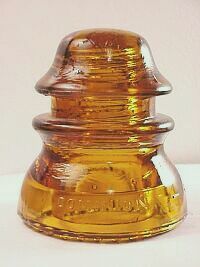
ADVERTISEMENT
Duquesne Glass Company
Carnegie, PA (1905-1907)
There has been a lot of uncertainty concerning the actual source of the insulators embossed “DUQUESNE GLASS CO.” Three types are known, all small telephone line styles: CD 106.1, CD 106.3, and CD 113.2. According to information uncovered by researcher Bob Stahr, the correct source of these insulators was the above-mentioned firm, located in Carnegie, PA, now a part of metropolitan Pittsburgh. The Duquesne Glass Company was incorporated in January of 1905, and was in operation for approximately two years. The glass was manufactured at a plant owned by the H. L. Dixon Company. In May of 1907 the plant itself was sold by Dixon to Superior Steel Company, and Superior gained occupancy in November of that year.
Another glass factory with the same name (i.e. Duquesne Glass Company) was located in Paden City, West Virginia, and was in business from about 1903 (some sources state 1905) to c. 1919. That operation was principally a bottle house, and did not produce insulators.
On a related note, information that has circulated for many years within the insulator-collecting world had mistakenly attributed the “Duquesne Glass Co.” insulators to a much earlier factory called the Duquesne Glass Works (note “WORKS” in name) of Belle Vernon, PA, which operated under various owners from about 1834 to 1886 or later.
[Bob Stahr]
Ellenville Glass Works
Ellenville, NY (1837-1896)
Ellenville Glass Works, widely known by antique bottle collectors for their base-marked cylinder whiskey bottles found in a range of colors, also produced glass insulators beginning in 1886, according to information on this webpage: http://www.waymarking.com/waymarks/WM4GV2_Glassworks_Site_Ellenville
To my knowledge, any such insulators (assuming some were actually manufactured there) currently remain unknown /unidentified to the insulator-collecting hobby.
H. C. Fry Glass Company
Rochester, PA (1901-1933)
Fry Glass made (at least) 5 different types of glass insulators that are known so far (4 pintypes) and all are unique styles and very rare. Most known examples were recovered from the factory dumpsite. Colors included opaque cobalt blue, milky opalescent, dark purple black glass, etc. The actual manufacture of these insulators occurred in the 1920s.
[McDougald-1990: Ray Lanpher]
Gayner Glass Company
Salem, NJ (1898-1975)
Although glassman John Gayner was involved in several ventures in the glass manufacturing field in Salem as far back as 1879, the official incorporation of the “Gayner Glass Works”, as such, did not occur until 1898. Insulators were evidently only produced during the period of 1920 to 1923. Most of the insulators they made are embossed “GAYNER” on the skirt area. Their main line of glass products consisted of various kinds of bottles and fruit jars.
R.Good Jr./Robert Good Jr.
(See Valverde Glass Works)
Hamilton Glass Company
Hamilton, Ontario, Canada (c.1864-1898)
[McDougald-1990: Eric Halpin, Morgan Davis] [Colin MacIntosh (Canadian Insulators) states dates as 1864-1895 with a note that Diamond Glass Company absorbed Hamilton Glass in 1894].
Harloe Insulator Company
Hawley, PA (c.1902-1906?)
Elmer, NJ (Mar 1903-Oct 1903)
This company made two unusual “no-tie” style insulators— the CD 109.5 and CD 206.5 styles. Harloe’s embossed marking is a logo / monogram consisting of the letters “H I Co” intertwined, above the words “Hawley, PA. U.S.A.”. Because of the embossing, Harloe insulators are often called “Hawleys” by collectors, although the actual company name was never “Hawley”. Ending date of insulator production at Harloe is uncertain but evidently in the 1905-1906 period. Harloe operated the Elmer, NJ “lower works” for a short while after the Sterling Glass Company ended it’s operation there. (Note: This company should not be confused with another glass company called the “Hawley Glass Company” which was located in Hawley, PA and in operation c. 1882-c. 1928, which produced bottles and fruit jars). [McDougald-1990: Bob Harding; Ray Klingensmith]
Hemingray Glass Company
Cincinnati, OH (1848-1852)
Covington, KY (1852-c.1890?)
Muncie, IN (1888-1933)
Muncie, IN (1933-1972) [Owens Illinois Glass Company]
Hemingray is the best known and was the most prolific glass insulator manufacturer in the world. Markings used by Hemingray include “HEMINGRAY”, “H.G.CO.”, “PATENT MAY 2 1893”, “PATENT DEC 19 1871”, “KIMBLE”, “LOWEX” and others. Glass insulators were made from at least as early as 1851, up to 1967. The Hemingray plant at Muncie (under Owens-Ilinois ownership) closed permanently in 1972. More information is here on the Hemingray Glass Company page.
Houston Glass Works/ Houston Glass Company
Houston, Texas (1903-1905)
Although no absolute proof has been discovered (yet), the chances are very high that this short-lived, obscure firm produced an enigmatic CD 102 pony insulator marked with an “HGW” monogram on the skirt. Only one example has been found to date, in a shade of light green, and it was purchased at a flea market in the Houston area.
Indiana Glass Company
Dunkirk, IN (1907-2002) & Sapulpa, OK (19? – plant later sold to Anchor Hocking and closed in 2008)
Indiana Glass Company (subsidiary of Lancaster Glass Corporation) has produced a tremendous variety of glassware throughout it’s long history. In 1967, the very last insulators carrying the Hemingray name were produced at the Indiana Glass Co. glass plant in Dunkirk, using molds and machinery shipped over from Muncie. For a site with more information on Indiana Glass, especially concerning their Carnival glass production, click here . Also, for a webpage on a very popular item made by Indiana Glass for many years, click here for my page spotlighting their “Hen on nest” dishes.
[Bob Stahr]
D. C. Jenkins Glass Company
Kokomo, Indiana (1906-1923) and Arcadia, Indiana (1913-1933)
This operation was known as Kokomo Glass Manufacturing Company from 1901 to about 1905, then renamed “D. C. Jenkins Glass Company” in 1906. The factory produced plain and pattern glass tableware but also other items such as chicken feeders, fish globes, candy containers, display jars, glass novelties and strain-type insulators. Some strain insulators are marked “D. C. J”.
[Sandy Stout Olander; EAPGS pattern information database]
Kearns & Company (G. W. Kearns; Kearns, Herdman & Gorsuch)
Zanesville, Ohio (1864-1886)
A check exists circa 1870 that indicates telegraph insulators were then being produced. Nothing is known about what type(s) these might have been.
[McDougald-1990: Ray Klingensmith, Bob Henrickson; Alice Creswick-The Fruit Jar Works]
Kerr Glass Manufacturing Corporation
(See Whitall Tatum Company webpage.)
King City Glass Works
Fairmount, IN (1890-1897)
Insulators marked “K.C.G.W.” were manufactured at this factory. The plant was bought by Marion Fruit Jar & Bottle Company in 1897. It is very likely that some insulators were produced by the M F J & B Co., re-using old molds from the King City operation.
Lancaster Glass Works
Lancaster, NY (1849-1904)
This factory is best known for their “LANCASTER / GLASS WORKS / N.Y.” marked blob top soda bottles as well as several different historical/pictorial flasks. Some of the firm names used include Reed, Shim & Co.; James & Gatchell; James Glass Works; and the Lancaster Cooperative Glass Works. The factory evidently started up again for a short time in the c.1907-1909 period. According to “American Bottles and Flasks and their Ancestry” (McKearin & Wilson, 1978), large quantities of telegraph insulators were produced in the Civil War era, but no details were provided on what types those might have been.
[McKearin & McKearin-American Glass(1941)]
ADVERTISEMENT
Louisville Glass Works
Louisville, KY (1855-1873)
John Stanger, along with several other glass men, started this factory in 1850 at the SE corner of Clay and Franklin Streets in Louisville. First known as the Kentucky Glass Works, it was being referred to as the Louisville Glass Works by 1855. Primarily, its products consisted of bottles, flasks, fruit jars, lamp chimneys, window glass and similar items, but an article published in a local business newspaper confirms that insulators were being produced at this factory in early 1866 for the Southwestern Telegraph Company (Louisville Industrial & Commercial Gazette, February 3, 1866 issue, page 83). The insulator style(s) manufactured there have not been identified. For more detailed information on this operation, please see this .pdf article published in 2005: Louisville Glass Factories of the 19th Century, Part One
Leonard Glass Works
Detroit, MI (c.1883-1886)
Evidence has recently surfaced that indicates Leonard Glass Works made insulators for the Chicago Insulating Company, making it likely that this firm produced many, if not all, of the insulators marked with the “Chicago Insulating Co.” embossing, i.e. CD 135 and CD 109.
[Dan Culver]
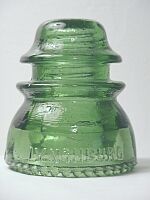
Lynchburg Glass Corporation
Lynchburg, VA (1923-1925)
Insulators embossed “LYNCHBURG” were made here. Although, according to production records, over 4 million insulators were made within less than 2 years’ time, as a result of various operational problems this factory ceased glass production in early 1925. Shown here is their “NO. 44” insulator. This type was a direct competitor to the ubiquitous Hemingray-42, made by Hemingray Glass Company. See more info on the Lynchburg Glass Corporation page.
Lyndeborough Glass Company
South Lyndeborough, New Hampshire (1866-1888)
The celebrated Lyndeboro’ glass factory, long known by Northeast region antique collectors as a maker of many beautiful bottles and whimseys, has recently been confirmed as the source of many (if not all) of the base-embossed American Insulator Company electrical insulators. [Mark Newton]
Marion Fruit Jar & Bottle Company
Fairmount, Indiana (1897-1904)
A possible producer of insulators. (See King City Glass Works). M F J & B Co was bought by Ball Bros. Glass Co. in 1904 and the plant was closed in 1910. [Alice Creswick-The Fruit Jar Works]
Massachusetts Glass Company
Somerville, MA (c.1867-1871)
[Predecessor of Boston Bottle Works]
Maydwell
See “Crystallite Products Corporation” entry.
S. McKee and Company
Pittsburgh, PA; Jeannette, PA (1834-1908)
This company produced threadless insulators, although the related “McKee Glass Company” (1854-1951), a separate operation, made large quantities of tableware as well as bottles, window glass and other glassware. Please click here for more info on the McKee companies: McKee Glass Company.
McLaughlin Glass Company
Vernon, CA (1920-1935)
William McLaughlin worked at Robert Good, Jr.’s glass factory at Valverde, Colorado before starting up his own glass factory in California. For more info see the page on McLaughlin Glass Company.
Mt. Pleasant Glass Works
Mt. Pleasant, NY (1844-1870?)
[McDougald-1990: Ray Klingensmith]
National Insulator Company
(See American Iron Glass Pipe & Plate Company)
Newburgh Glass Company
Newburgh (New Windsor), NY (c.1867- c.1872)
This concern was also known as the “New Windsor Glass Works” (in at least one source, i.e. The Telegrapher, 1867). Although Newburgh Glass Company appears to have made primarily bottles, it has recently been discovered (from brief articles in that same trade newspaper) that they also manufactured telegraph insulators, including at least some, if not many, of the insulators marketed by L.G. Tillotson in the late 1860s.
New England Glass Company
Cambridge, MA (1818-1888)
This factory was principally a producer of fine tableware and upscale glass items. Evidence strongly suggests that threadless insulators were made in the c.1846-1850 period for Ezra Cornell, who was involved in the construction of early telegraph lines in New York and other areas in New England. [McDougald-1990: Ray Klingensmith]
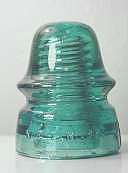
New England Glass Manufacturing Company
Boston, MA (1898-1900)
Insulators marked “N.E.G.M.CO.” were made by this firm. Although the factory was reportedly listed only in the 1899 Boston directory, it is believed that actual glass production started in 1898, and might have lasted into early 1900 before the new directory was printed.
New Granite Glass Works
Stoddard, NH (1861-1871)
An early trade card from this glassworks advertised insulators, both telegraph and lightning rod styles. Evidence from excavation at the former factory site indicates they made at least some, if not all, of the unmarked dark olive green “blackglass” CD 738 threadless style insulators. [McDougald-1990: Ray Klingensmith, quoting Ken Wilson; description re Heckler auction item]
Novelty Glass Company
Elmer, NJ (1901-1903)
Maker of many, if not most, of the “KNOWLES” embossed insulators. Many of the insulators that were made by Novelty are seen in shades of medium & darker greens. A number of the “STAR” embossed insulators were produced at this factory. Although Novelty Glass was dissolved in 1903, the factory itself may have produced insulators as late as 1907 under a succeeding firm’s ownership.
Oakman Manufacturing Company
Mercer Street, Boston, MA (1890-1897)
[McDougald-1990: Joe Maurath,Jr.]
ADVERTISEMENT
Ohio Valley Glass Company
Pleasant City, OH (1902-1905)
This manufacturer made a variety of glass electrical insulators marked “O.V.G.CO.” Please click here to go to my page on this glass works: Ohio Valley Glass Company.
Opalescent Glass Company
Kokomo, IN (1888-to date)
Insulators (types unknown at present) were reportedly made here from 1888 to 1896.[Paul Crist, Bob Stahr]
Owens-Illinois Glass Company
Toledo, OH [former head office] (1929- to present)
Owens-Illinois Glass Company was the product of a merger in 1929 of two large glass companies, the Illinois Glass Company (of Alton, Illinois), and the Owens Bottle Company which was headquartered in Toledo, Ohio. After the merging, the total number of plants owned by Owens-Illinois numbered more than 20 in several states, with each assigned a plant code number. In 1933 Owens Illinois bought the Hemingray Glass Company plant in Muncie, Indiana, and it then became Owens-Illinois plant #26. Glass insulators were made by O-I at Muncie (carrying the Hemingray name) until 1967. (More info under Hemingray).
Pacific Glass Works
San Francisco, CA (1862-1876)
Either this factory OR the San Francisco Glass Works was in all probability the manufacturer of the E.C.& M.CO. insulators. Merged with SFGW to form the San Francisco & Pacific Glass Works in 1876.
Richmond Glass Works (Virginia Glass Mnfg. Company)
Richmond, VA (1855-1865)
This factory produced some of the threadless “egg” style insulators, as evidenced by specimens found during excavation at the factory site. [McDougald-1990: Ray Klingensmith]
Sandwich Cooperative Glass Company
Sandwich, MA (May 1890-November 1890)
The Electrical Glass Corporation (director, James Pennycuick) bought the old Boston & Sandwich factory (which had closed in 1888) in December of 1889 and it was later known as the Sandwich Cooperative Glass Co. For several months in 1890, glass insulators were evidently made here, but the exact types are unknown. It is speculated that some of the Pennycuick-style threaded insulators may have been made at this factory, including “Diamond-P” ; “C.E.L.CO.”; and “Pettingell-Andrews” embossed CD 134s, and perhaps other unembossed, and as yet unattributed, examples. It isn’t clear how long, or where, the Electrical Glass Corporation made insulators previous to this period of time, assuming they did produce others. [McDougald-1990: Joe Maurath, Jr.]
San Francisco Glass Works
San Francisco, CA (1865-1876)
This factory was the likely source of most, if not all, of the E.C.& M.CO. insulators. SFGW merged with the Pacific Glass Works (started 1872) in 1876 to form the San Francisco & Pacific Glass Works (1876-c.1901). Insulators might date from after that merger as well.
St. Johns Glass Company
St. Johns, Quebec, Canada (1875-1877)
[McDougald-1990: Morgan Davis]
Standard Glass Insulator Company
Boston, MA (1893-1894)
Star Glass Works
New Albany, IN (1869-1879)
There is no proof that this company ever made electrical insulators, although a book about New Albany glass history (by Gerald O. Haffner) implies that it did. Please see my article here with more detailed information on Star Glass Works.
Sterling Glass Company
Elmer, NJ (June 1902-March 1903)
This firm manufactured insulators marked “STERLING” and/or “£”, as well as some of the “star” insulators. [McDougald-1990: Ray Klingensmith]
Thames Glass Works
New London, CT (1863-1865)
Only one intact insulator (CD 718, a threadless type) is known, along with about 3 to 6 known broken/partial examples (the exact number of known partials is unclear, there being some discrepancy among published reports). The insulators are embossed “THAMES GLASS WORKS” on the front of the crown, and “NEW LONDON, CT” on the rear crown. They are made of a very dark olive amber black glass.
Valverde Glass Works (aka Robert Good,Jr.; Colorado Glass Works; Denver Flint Glass Company)
Denver, CO (1896-1899)
[McDougald-1990: Don Reinke, Mike Miller]
Virginia Glass Manufacturing Company
(See Richmond Glass Works)
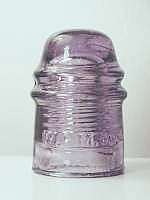
Western Flint Glass Company/Western Glass Manufacturing Company
Denver, CO (1899-1900); (1900-1909)
The markings “W.F.G.CO.” and later, “W.G.M. CO.” are found on insulators from this factory. The WFG’S have been found in many odd shades of color, but the WGM’s are usually found in various shades of purple. [McDougald-1990: Don Reinke, Mike Miller]
Whitall Tatum Company/Armstrong Cork Corporation/Kerr Glass Mnfg. Corporation
Millville, New Jersey (1857-1938); (1938-1969); (1969-1978). [First insulators made in 1922, last insulators made in 1978]
The first glass factory in Millville, New Jersey was started in 1806 by James Lee… more
Willington Glass Works
West Willington, Connecticut (1814-1872). An early blown, conical, 8 sided glass object in a dark yellowish olive amber color marked “PATENT” (said to be an insulator) has been attributed to Willington, but most serious insulator collectors no longer believe it to have been intended as an actual insulator. It might have been an early type of curtain rod finial, possibly dating from the 1840s – 1860s period. (Although this doesn’t eliminate the possibility that the company could have made some currently-unidentified threadless telegraph insulators during their many years in business! There are many CD styles of threadless of which nothing is known as to actual maker.)
E. Wormser & Company / Wormser Glass Company
Pittsburgh, PA (c.1854-1875; 1875-c.1927)
This factory is believed to be the source of certain unembossed insulators, including CD 120s, and 133.4 “bullets”. The great majority of examples are found in shades of SCA (sun colored amethyst), ranging from a light pink to a medium-dark purple (similar to a typical Whitall Tatum No.1 in purple). A few CD 120s in clear glass exist but are very rare. Aqua examples are known but are extremely rare. A receipt dated September 5, 1884 indicates that 1000 insulators (unspecified type) made by Wormser Glass Co. were sold to the Central District & Printing Telegraph Company. The factory address at that time is shown as “Laughlin Station, B. & O. R.R. Pittsburgh, Pa.” I also saw a business letterhead for sale on ebay some time ago which was dated 1906. Toulouse (Bottle Makers and their Marks-1971) indicates this company closed c. 1929. Alice Creswick gives ending date as 1927. [Brent Burger]
Click here to go to my webpage GENERAL OVERVIEW ON GLASS INSULATORS.
Please click here to go to my HOME PAGE.
For an extensive list of glass manufacturers’ marks on bottles, fruit jars, insulators, tableware and other items, please click here to go to the GLASS BOTTLE MARKS pages, (page one).
Click here to check out my page on the so-called “Crackle Glass” insulators.
This page discusses recently color-altered glass, including insulators, bottles and other types of collectible glassware: Artificially Purpled Glass.
Click here for a basic summary page on WHAT IS GLASS?
Occasionally, worn pieces of old insulators are found as so-called “Sea Glass” or “Beach Glass”. Check out my article about that type of collectible glass here: Sea Glass / Beach Glass.
For some info on numbers embossed on the bottoms of glass bottles and jars, check out this page.
ADVERTISEMENT
RESOURCES / GENERAL INFO CONCERNING INSULATORS
https://www.insulators.info/ . Lots of good general information on Glass & Porcelain insulators, and the hobby of collecting insulators!! This site was created by Bill and Jill Meier. Bill Meier started the ICON (Insulator Collectors on the Net) email discussion group /forum which has been around since 1996!!
https://www.nia.org/ . (National Insulator Association). Great background information with articles covering the many fields of collectible insulators.
https://www.collectinginsulators.com/. Rick Soller’s informational website—this site covers a lot of insulator-related “specialty” topics!
https://www.r-infinity.com/ Elton Gish’s very cool website with extensive information on collectible porcelain insulators of all types. Elton has written several books about porcelain insulators.
https://www.r-infinity.com/Companies/index.htm This particular page on Elton Gish’s site (above) has an EXTENSIVE list of both glass AND porcelain insulator manufacturers and distributors!! This might be the best all-inclusive page on the internet with detailed information not found elsewhere on many obscure companies, many of them makers of porcelain spool and cleat insulators and other kinds of non-pintype insulators.
https://www.insulators.info/porcelain/mark.htm This link points to one of the pages on insulators.info, this page illustrating some of the markings seen on porcelain insulators. Great pics of some more unusual colored porcelain pieces!
https://allinsulators.com/ This site is a project by Shaun Kotlarsky, and is a monumental work in progress, showing pictures and info concerning all kinds and types of insulators! Check it out!!
https://lynchburgglass.info/ Dennis Bratcher’s website – lots of great, detailed information here, all about Lynchburg Glass Corporation and Lynchburg insulators:
https://www.hemingray.info/
Christian Willis’s site with tons of information about Hemingray insulators!
ADVERTISEMENT

